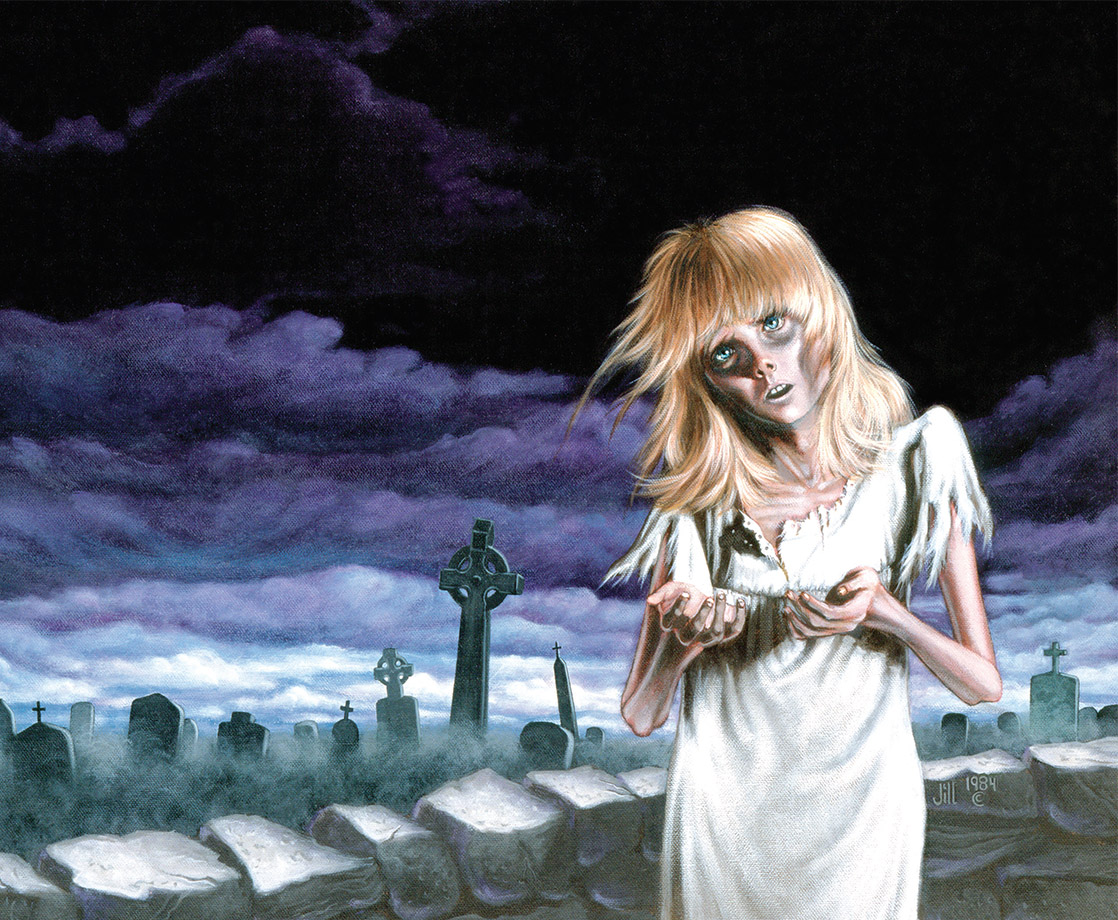All images courtesy of Grady Hendrix and Quirk Books
From about the same time The Exorcist and The Omen took off by terrifying moviegoers in the 1970s and continuing on up until the big-screen Freddy and Jason slasher flick franchises flamed out at the end of the following decade, a parallel world of horror hits spooked pop culture in readable form.
Wild books focusing on way-out fright fare such as teens turned supernatural sadists, possessed pets, apocalyptic infants, suburban Satan-worshippers, inner city demon hunters, Native American mystic monsters, and even Nazi elves run amuck flooded mass-market publishing. Pocket novels brandishing garish, exquisitely painted, and entirely horrifying cover art cropped up in bookstores, libraries, and, most memorably, in spinning wire racks at supermarkets, newsstands, and drugstores — where they'd often be perfectly placed at a kids' eye-level.
One such tyke who took in all that petrifying pulp was Grady Hendrix, author of the new compendium on the topic, Paperbacks From Hell (out now through Quirk Books). Hendrix also grew up to be a hugely successful writer of horror fiction himself. He penned the acclaimed and astonishing Horrorstör (about a cosmically infernal, Ikea-esque furniture outlet), which NPR named one of its Best Books of 2014 and which is presently being adapted into a TV series.
For Paperbacks From Hell, though, Hendrix returned to collect, chronicle, and curate the scary scribes of his youth and the diabolically-designed products they pumped out, page after hair-raising page. Grady Hendrix took some time to talk to MERRY JANE about PBH, a reference tome so entertaining, so authoritative, and so brilliantly assembled it's frightening.

MERRY JANE: Paperbacks From Hell is a book the world has been screaming for — even if we weren't all entirely aware of it. How did it come to be?
Grady Hendrix: I'm a film guy first and there's always been a tradition in film of fans going out into the wild and coming back with the weirdest, most obscure movies they could find. I didn't see this with books, or at least not on a large scale, so I started reading all the weird old paperbacks I could find and wrote about them over at [the fantasy culture site] Tor.
There were so many of these horror paperbacks, I started to wonder how they went extinct, kind of like the way paleontologists kept finding dinosaur fossils and then wondered what happened to all those giant lizards. That coincided with my editor at Quirk Books giving me a call and asking if I wanted to write a book that was like my Tor columns, only bigger and badder… and with more artwork.
For me, this was the equivalent of a phone call from Ruby Keeler asking if I wanted to go to a tropical island stocked with bales of marijuana and have an orgy for three months. Of course I said yes. We had a tough time getting this book on the schedule at Quirk and when we finally got a green light I had to work fast. Basically from phone call to publication was about one year, which is crazy-short for a book like this. So many words! So many facts!

"The Abyss," courtesy of Terry Oakes and Quirk Books
Many kids of the 1970s and '80s recall being terrified by these very paperback covers. Did these books scare you growing up?
These covers really grossed me out as a kid and I actively avoided them because they made me way too anxious. I read a lot more science fiction and men's adventure novels like Hardwired and The Park Is Mine, because I was obsessed with the idea of figuring out how to survive a nuclear war.
Most of my horror exposure came from movie magazines like Fangoria. I wasn't allowed to watch R-rated movies, so after my Cub Scout meetings we would all get taken to the Oasis gas station across the street to buy snacks and I convinced my Scoutmaster that my parents were totally OK with me using my snack money to buy Fangoria, instead.
I'd inhale all these features and reviews on horror movies I wasn't allowed to see, then pretend I'd watched them. Everyone in carpool remembers me describing the plot of Friday the 13th Part II to them in great detail. I didn't actually see the movie until 2010.

"Feast," courtesy of Bob Larkin and Quirk Books
How many of the books in Paperbacks From Hell have you actually read?
All of them. Years ago, I was a freelance writer for a bunch of newspapers and I did an article about an Ousmane Sembène retrospective when I hadn't seen enough of his movies. I faked having seen a couple of them, and while I was never called out, I was mortified. I vowed then and there never to write about any book I hadn't read from cover to cover and any movie I hadn't seen from beginning to end.
If a book gets mentioned in the text of Paperbacks from Hell, I've read the whole thing. And I read about 90% of the books that are just featured as cover art. All told, I read something like 326 books in a year to write Paperbacks. There were days when I could read six books, but those days broke me and I couldn't read anything the next day. My average was about two books per day, although there were a lot of days where I got through four.
Does marijuana play a significant role in any of the PBH books?
William W. Johnstone's insane novels [such as Toy Cemetery] about Satanic toy factories overrunning America with demonic dolls cite drug use as the reason why teenagers turn to Satan and engage in anal sex. And Brian Hodge's Night Life is basically Miami Vice meets Crocodile Dundee, only with bright green cocaine that turns people into were-piranhas. But otherwise, these books are mostly drug free.
However, if you have any romantic yearnings for the old days of the drug trade, when dealers put on leather jackets and sat in run-down bars by the Port Authority, dealing weed in the bathrooms to dudes with mustaches and groovy chicks, while Marvin Gaye and the O'Jays played on the jukebox, then lots of these books deliver that old school urban attitude, from Bari Wood's Tribes to Tom Lewis's Rooftops.

"Maggots," courtesy of Terry Oakes and Quirk Books
What's the actual best book we haven't heard of that you cover in PBH?
It's not the best book, but I'd recommend The Black Exorcist to anyone. There were very few African-American horror paperbacks back in the day, and this is one of them. It's a blaxploitation version of The Exorcist, written by Joseph Nazel, a writer whose alarming productivity was only matched by the amount of rage he felt towards mainstream society. It's one of only four African-American horror novels I could find, and it's angry, outrageous, crude, and a whole lot of fun.
What's the single most insane book in PBH?
I'd have to say that award goes to Russ Martin's bonkers series of books about a Satanic mind control cult secretly running the world: The Devil and Lisa Black, The Possession of Jessica Young, The Obsession of Sally Wing, The Desecration of Susan Browning, and The Education of Jennifer Parrish.
They posit that civilization is thin veneer that hides the fact that our lives are run by a cabal of Satanists with psychic powers and perverted hungers. Main characters from one book show up as ancillary characters in another, side characters become main characters, the events of earlier books are spoken of as rumors in later ones. Martin weaves a whole shared universe mythology over the course of these five paperbacks and they all read like PG-13 softcore erotica you might find online these days, only with more murder and Satanism.
Which book in PBH would you most like to see turned into a movie?
None of them! These books are all way too weird and wonderful to want them to get dumbed down by Hollywood. That said, I really wish the animal attack genre would make a big screen comeback, as well as the Native American curse story. Both of these have fallen into disuse, but it's about time that undead First Nations shaman and angry kitty cats started murdering humanity again.

"Fangs," courtesy of Thomas Hallman and Quirk Books
What are some of the main underlying points that tie all these novels together?
These books are timeless in the way that really matters: they know how to tell a story. Every single one of these writers had to fight tooth and nail in a brutal marketplace for every single one of their readers and so they learned how to hook eyeballs by writing books that move, that go for broke, that take risks.
They really only follow one rule: never be boring. The results may vary, but whether you're reading a masterpiece about underground incest babies or a bizarre trainwreck that leads to an army of killer rabbits invading England, you're compelled to keep turning the pages to find out what happens next.
What's next for you?
I'm just wrapping up my novel that'll be out in the fall of 2018 called We Sold Our Souls, which is about a heavy metal band that accidentally sold their souls to the Devil back in the '90s, and now they're trying to deal with it.
For more on Grady Hendrix, visit his website here and order a copy of "Paperbacks from Hell" through Quirk Books here
Follow Mike McPadden on Twitter











